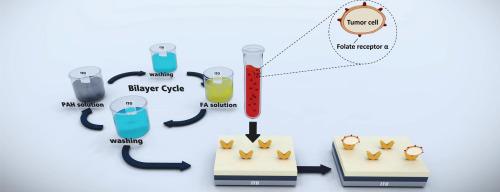Bioelectrochemistry ( IF 4.8 ) Pub Date : 2020-10-15 , DOI: 10.1016/j.bioelechem.2020.107685 Abilene Rodrigues Correia 1 , Isabella Sampaio 1 , Edson José Comparetti 1 , Nirton Cristi Silva Vieira 2 , Valtencir Zucolotto 1

|
Folate receptor alpha (FR-α) is a glycoprotein overexpressed in tumor cell surfaces, especially in gynecologic cancers, and can be used as a biomarker for diagnostics. Currently, FRα is quantified by positron emission tomography (PET) or fluorescence imaging techniques. However, these methods are costly and time-consuming. We report on the development of an electrochemical biosensor for FRα detection based on the use of nanostructured layer-by-layer (LbL) films as modified electrodes. Multilayer films were deposited on indium tin oxide (ITO) electrodes by the alternately assembling of positively charged polyallylamine hydrochloride (PAH) and negatively charged folic acid (FA), used as the biorecognition element. UV–vis and FTIR spectroscopies revealed the successful PAH and FA adsorption on ITO. Devices performance was evaluated by cyclic voltammetry (CV) and electrochemical impedance spectroscopy (EIS). The [PAH/FA] films presented a good reproducibility (RSD of 1.12%) and stability when stored in the Tris-HCl solution (RSD 6.7%). The biosensor electrochemical response exhibited a linear relationship with FRα concentration in the range from 10 to 40 nM. The limit of detection reached for CV and EIS measurements were 0.7 and 1.5 nM, respectively. As a proof-of-concept, we show that the devices can differenciate tumor cells from healthy cell, showing an excellent selectivity. The biosensor device based on [PAH/FA] films represents a promising strategy for a simple, rapid, and low-cost cancer diagnosis through FRα quantification on the surface of cancer cells.
中文翻译:

优化的PAH /叶酸逐层膜作为用于检测叶酸受体的电化学生物传感器
叶酸受体α(FR-α)是一种在肿瘤细胞表面过表达的糖蛋白,尤其是在妇科癌症中,可以用作诊断的生物标志物。目前,FRα通过正电子发射断层扫描(PET)或荧光成像技术进行定量。但是,这些方法既昂贵又费时。我们报告了基于纳米结构的逐层(LbL)膜作为修饰电极的FRα检测电化学生物传感器的发展。通过交替组装带正电荷的聚烯丙胺盐酸盐(PAH)和带负电荷的叶酸(FA),将多层膜沉积在氧化铟锡(ITO)电极上,用作生物识别元件。紫外可见光谱和傅立叶红外光谱表明,PAH和FA在ITO上成功吸附。通过循环伏安法(CV)和电化学阻抗谱(EIS)评估器件性能。[PAH / FA]薄膜在Tris-HCl溶液中保存时具有良好的重现性(RSD为1.12%)和稳定性(RSD为6.7%)。生物传感器的电化学响应与FRα浓度在10至40 nM之间呈线性关系。CV和EIS测量的检测极限分别为0.7和1.5 nM。作为概念验证,我们证明了该设备可以区分肿瘤细胞与健康细胞,显示出极好的选择性。基于[PAH / FA]膜的生物传感器设备代表了通过在癌细胞表面进行FRα定量进行简单,快速和低成本癌症诊断的有前途的策略。[PAH / FA]薄膜在Tris-HCl溶液中保存时具有良好的重现性(RSD为1.12%)和稳定性(RSD为6.7%)。生物传感器的电化学响应与FRα浓度在10至40 nM之间呈线性关系。CV和EIS测量的检测极限分别为0.7和1.5 nM。作为概念验证,我们证明了该设备可以区分肿瘤细胞与健康细胞,显示出极好的选择性。基于[PAH / FA]膜的生物传感器装置代表了通过在癌细胞表面进行FRα定量进行简单,快速和低成本癌症诊断的有前途的策略。[PAH / FA]薄膜在Tris-HCl溶液中保存时具有良好的重现性(RSD为1.12%)和稳定性(RSD为6.7%)。生物传感器的电化学响应与FRα浓度在10至40 nM之间呈线性关系。CV和EIS测量的检测极限分别为0.7和1.5 nM。作为概念验证,我们表明该设备可以区分肿瘤细胞与健康细胞,显示出极好的选择性。基于[PAH / FA]膜的生物传感器设备代表了通过在癌细胞表面进行FRα定量进行简单,快速和低成本癌症诊断的有前途的策略。生物传感器的电化学响应与FRα浓度在10至40 nM之间呈线性关系。CV和EIS测量的检测极限分别为0.7和1.5 nM。作为概念验证,我们表明该设备可以区分肿瘤细胞与健康细胞,显示出极好的选择性。基于[PAH / FA]膜的生物传感器设备代表了通过在癌细胞表面进行FRα定量进行简单,快速和低成本癌症诊断的有前途的策略。生物传感器的电化学响应与FRα浓度在10至40 nM之间呈线性关系。CV和EIS测量的检测极限分别为0.7和1.5 nM。作为概念验证,我们表明该设备可以区分肿瘤细胞与健康细胞,显示出极好的选择性。基于[PAH / FA]膜的生物传感器设备代表了通过在癌细胞表面进行FRα定量进行简单,快速和低成本癌症诊断的有前途的策略。











































 京公网安备 11010802027423号
京公网安备 11010802027423号